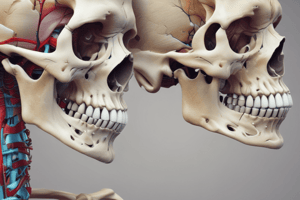Podcast
Questions and Answers
What is the mechanism of action of oestrogen in decreasing bone resorption?
What is the mechanism of action of oestrogen in decreasing bone resorption?
- Increasing transcription of genes RANKL and cytokines
- Stimulating osteoclasts and inhibiting osteoblasts
- Decreasing gene expression by binding to nuclear oestrogen receptor
- Inhibiting osteoclasts and increasing osteoblast proliferation (correct)
What is the effect of strontium ranelate on bone formation and resorption?
What is the effect of strontium ranelate on bone formation and resorption?
- Has no effect on bone resorption and formation
- Increases both bone resorption and formation
- Increases bone resorption and decreases bone formation
- Decreases bone resorption and increases bone formation (correct)
What is the benefit of using Selective Estrogen Receptor Modulators (SERM) over Hormone Replacement Therapy (HRT)?
What is the benefit of using Selective Estrogen Receptor Modulators (SERM) over Hormone Replacement Therapy (HRT)?
- Reduced risk of breast cancer (correct)
- Increased bone mass
- Reduced risk of venous thromboembolism
- Reduced risk of endometrial cancer
Why is strontium ranelate an alternative to bisphosphonates in the prevention of osteoporosis in postmenopausal women with increased risk of breast cancer?
Why is strontium ranelate an alternative to bisphosphonates in the prevention of osteoporosis in postmenopausal women with increased risk of breast cancer?
What is the effect of RANKL on bone resorption?
What is the effect of RANKL on bone resorption?
What is the mechanism of action of Hormone Replacement Therapy (HRT) in bone?
What is the mechanism of action of Hormone Replacement Therapy (HRT) in bone?
What is the risk associated with the use of Hormone Replacement Therapy (HRT)?
What is the risk associated with the use of Hormone Replacement Therapy (HRT)?
What is the mechanism of action of decoy receptor in terminating RANKL activity?
What is the mechanism of action of decoy receptor in terminating RANKL activity?
Why is it recommended to consider dental examination prior to treatment in those with risk factors for ONJ?
Why is it recommended to consider dental examination prior to treatment in those with risk factors for ONJ?
What is the effect of Selective Estrogen Receptor Modulators (SERM) on bone mass?
What is the effect of Selective Estrogen Receptor Modulators (SERM) on bone mass?
Flashcards are hidden until you start studying
Study Notes
Bone Composition and Calcium Homeostasis
- Bone is composed of 25% organic matrix (osteoid, type 1 collagen fibers, cells: osteoblasts, osteoclasts, osteocytes) and 75% inorganic matrix (crystalline calcium and phosphate salts, primarily hydroxyapatite)
- Bone plays a crucial role in maintaining overall body calcium homeostasis
- 99% of total body calcium is stored in bone as crystalline hydroxyapatite
Regulation of Bone Remodeling
- Bone remodeling is a continuous process regulated by hormones, mechanical factors, and cytokines
- Osteoblasts (formation) and osteoclasts (resorption) are key cells involved in bone remodeling
- Glucocorticoids, thyroid hormone, and estrogen have a greater impact on bone remodeling in cases of deficiency or excess
- Parathyroid hormone (PTH) is the principal regulator of calcium homeostasis and balance
- Vitamin D contributes to maintaining calcium balance
Bone Disorders and Pharmacological Agents
- Osteoporosis is a bone disorder characterized by an imbalance between bone resorption and formation, leading to increased bone fragility and susceptibility to fracture
- Parathyroid hormone (PTH) analogues are anabolic agents that increase bone formation
- Antiresorptive agents, such as bisphosphonates, hormone replacement therapy (HRT), and selective estrogen receptor modulators (SERMs), slow down bone loss
- RANKL antagonists and calcimimetic compounds, such as cinacalcet, are used to treat hyperparathyroidism
Parathyroid Hormone (PTH) Effects
- PTH acts to increase and maintain plasma calcium levels through direct and indirect effects on bone and kidney
- PTH increases calcium reabsorption and promotes phosphate excretion in the kidney
- PTH has anabolic and catabolic effects on bone, with anabolic effects increasing bone formation and catabolic effects increasing bone resorption
- The anabolic window refers to the early bone formation events and increased bone mass seen with intermittent low-dose exposure to PTH
Teriparatide and Bisphosphonates
- Teriparatide is a recombinant human parathyroid hormone (PTH 1-34) used to promote bone formation in severe osteoporosis
- Bisphosphonates are bone anabolic agents that inhibit bone resorption by modifying osteoclast activity and increasing bone mass
- There are two classes of bisphosphonates: non-nitrogen-containing bisphosphonates (NNBPs) and nitrogen-containing bisphosphonates (NBPs)
- Examples of bisphosphonates include etidronate, alendronate, ibandronate, risedronate, and zoledronate
Hormone Replacement Therapy (HRT) and Selective Estrogen Receptor Modulators (SERMs)
- Hormone replacement therapy (HRT) and selective estrogen receptor modulators (SERMs) are antiresorptive agents that slow down bone loss
- Raloxifene is a SERM that has tissue-selective effects, stimulating osteoblasts and inhibiting osteoclasts
- Strontium ranelate is an alternative to bisphosphonates for the prevention of osteoporosis in postmenopausal women with increased risk of breast cancer
Studying That Suits You
Use AI to generate personalized quizzes and flashcards to suit your learning preferences.



